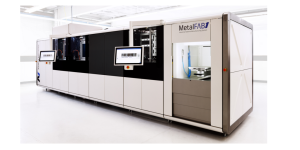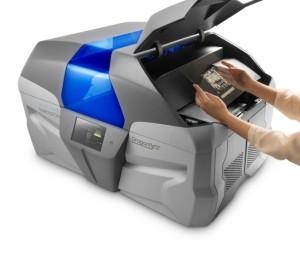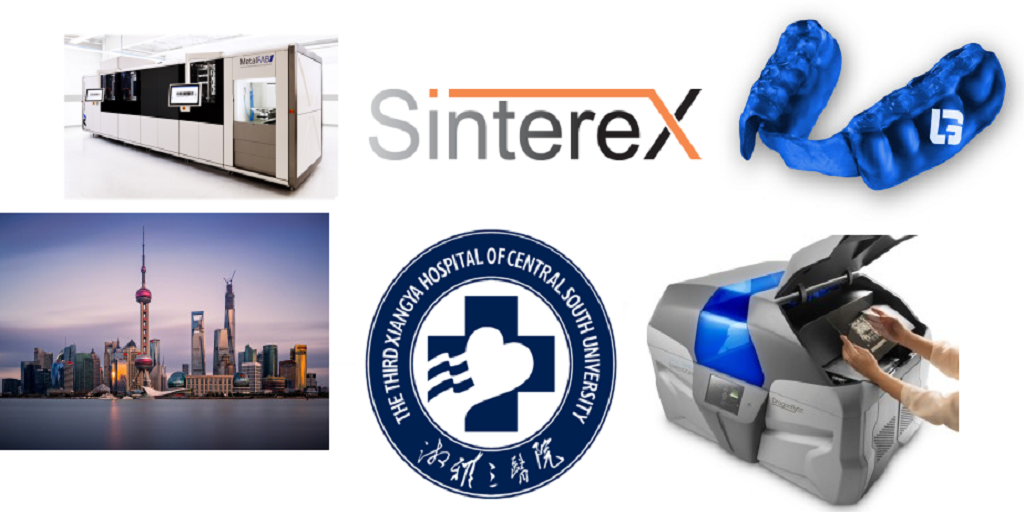This week’s 3D printing news takes us all over the place as we see 3D printing popping up in new places and being used for some new purposes. We begin with 3D printed athletic mouthguards from GuardLab, which has a big fan in baseball great José Bautista. Bautista now serves on the company’s athlete advisory board. Then we move on to metal printing, as a Red Dot Award has been received by Additive Industries along with design team VanBerlo for its MetalFAB1 design. In other metal printing news, the United Arab Emirates is where Sinterex has set up shop to 3D print metal, in a first for the region. Also, Israel’s Nano Dimension Technologies has filed for a patent for its PCB, which is intended for use in the telecommunications industry. Finally, we turn to two 3D printing stories from China to round off this diverse and international week of 3D printing news.
Toronto Blue Jays’ José Bautista Joins GuardLab’s Advisory Board
Th e 3D scanned and printed mouthguard manufacturing company GuardLab announced that José “Joey Bats” Bautista will be the company’s new brand ambassador. Bautista, originally from the Dominican Republic, is a Toronto Blue Jays outfielder and six-time Major League Baseball All-Star. He is also the most recent member of the company’s athlete advisory board. Last year was Bautista’s first exposure to the Lower Performance Mouthguard when GuardLab used 3D scanning to custom fit several Blue Jays players. This unique neuromuscular guard, developed with the help of two world-class dentists using proprietary methods, aids with many traditional problems caused by other mouthguards.
e 3D scanned and printed mouthguard manufacturing company GuardLab announced that José “Joey Bats” Bautista will be the company’s new brand ambassador. Bautista, originally from the Dominican Republic, is a Toronto Blue Jays outfielder and six-time Major League Baseball All-Star. He is also the most recent member of the company’s athlete advisory board. Last year was Bautista’s first exposure to the Lower Performance Mouthguard when GuardLab used 3D scanning to custom fit several Blue Jays players. This unique neuromuscular guard, developed with the help of two world-class dentists using proprietary methods, aids with many traditional problems caused by other mouthguards.
Bautista comments here on how his overall alignment is improved with the GuardLab mouthguard:
“I never knew that a mouthguard could impact training, recovery and performance. The lower guard I wear helps me get into alignment, breath better and create less tension throughout my body during movements. This is a piece of sports equipment that I believe in, and I’m looking forward to joining the GuardLab advisory board to advocate the use of mouthguards by baseball players and other athletes, whether professional or amateur.”
These revolutionary 3D printed mouthguards can make baseball more enjoyable for athletes because stabilization of the mouth, jaw, and neck region aids the alignment of the entire body — improving overall health, comfort, and performance. It sounds like Bautista will make an excellent brand ambassador for these mouthguards, since it’s a piece of equipment that he loves to wear.
Red Dot Award Goes to MetalFab1 3D Printer
Additive Industries and its design partner VanBerlo have won the Red Dot Award for their industrial 3D metal printing system, MetalFAB1. This printer is the company’s first integrated additive manufacturing machine for high-end metal parts, and its VanBerlo-designed exterior reflects advanced industrial technology’s aesthetics. The Red Dot Award honors innovative design concepts, and VanBerlo was inspired by the MetalFAB1’s unique qualities. “Stress relief heat treatment, automated build plate handling and storage” are all “integrated in one industrial grade production system” — according to the company’s website.
and its design partner VanBerlo have won the Red Dot Award for their industrial 3D metal printing system, MetalFAB1. This printer is the company’s first integrated additive manufacturing machine for high-end metal parts, and its VanBerlo-designed exterior reflects advanced industrial technology’s aesthetics. The Red Dot Award honors innovative design concepts, and VanBerlo was inspired by the MetalFAB1’s unique qualities. “Stress relief heat treatment, automated build plate handling and storage” are all “integrated in one industrial grade production system” — according to the company’s website.
Daan Kersten, co-founder & CEO of Additive Industries, comments on the award:
“Design is often overlooked but crucial for a successful acceptance of new technology like 3D metal printing. I’m confident the design of both the equipment and the user interface have contributed greatly to the early sales of our MetalFAB1 systems.”
United Arab Emirates Opens Metal 3D Printing Facility
 Speaking of metal 3D printing, the Middle East has just stepped up its presence in this notably growing sector of the 3D printing industry. The company Sinterex has established a facility in Ras al-Khaimah, which is about a 1.5 hour drive from Dubai. Metal 3D printing, or metal additive manufacturing, has grown more popular in the past few years as a way to dramatically reduce waste, expense, and lead times in the manufacturing process.
Speaking of metal 3D printing, the Middle East has just stepped up its presence in this notably growing sector of the 3D printing industry. The company Sinterex has established a facility in Ras al-Khaimah, which is about a 1.5 hour drive from Dubai. Metal 3D printing, or metal additive manufacturing, has grown more popular in the past few years as a way to dramatically reduce waste, expense, and lead times in the manufacturing process.
Sinterex’s Technical Director, Alaa Elwany, explains the current attraction to metal 3D printing:
“In the current slow economic and low oil price environment companies are under increasing pressure to identify areas for cost reduction and value enhancement. These goals can be achieved through Metal Additive Manufacturing.”
Sinterex plans to concentrate its printing efforts on regional energy, aviation, and manufacturing firms, and the company will also offer market research and consulting services.
Nano Dimension Technologies Files for PCB Patent
Nano Dimension Ltd . is an Israel-based international leader in 3D printed electronics. The company recently announced that its subsidiary, Nano Dimension Technologies, has filed a patent application with the US Patent and Trademark Office. This patent is for the 3D printing of scaled down “shielded conductors combined in a printed circuit board (PCB)” — a technology used mainly in the high speed telecommunications industry.
. is an Israel-based international leader in 3D printed electronics. The company recently announced that its subsidiary, Nano Dimension Technologies, has filed a patent application with the US Patent and Trademark Office. This patent is for the 3D printing of scaled down “shielded conductors combined in a printed circuit board (PCB)” — a technology used mainly in the high speed telecommunications industry.
High-speed boards are essential to the telecommunications industry; they are a central component of the rapid servers that allow real-time data implementations. However, the boards can also cause “losses between the conductive traces (CROSSTALKS) and other phenomena arising from the multiplicity of signals.” This loss keeps electric circuits from functioning properly, and Nano Dimension believes it has a solution.
Nano Dimension’s unique 3D printing method, which uses its proprietary conductive ink, creates sheaths that work like a form of insulated cable to shield conductors. This helps prevent losses in high-speed boards by building or embedding sheaths directly into the PCB object, which also minimizes PCB sizes.
3D Printing Used by Chinese Funeral Parlor
 We know that 3D printing is growing in leaps and bounds in China, but at a funeral home? The Longhua Funeral Parlor in Xuhui District set up a 3D printing studio so it can repair damaged bodies. If a corpse has been in an accident, fire, or natural disaster, it can upset loved ones. 3D printing is being called on to repair the damage before burial. Overall, about a 95% success rate has already been claimed for this 3D printed cosmetic process.
We know that 3D printing is growing in leaps and bounds in China, but at a funeral home? The Longhua Funeral Parlor in Xuhui District set up a 3D printing studio so it can repair damaged bodies. If a corpse has been in an accident, fire, or natural disaster, it can upset loved ones. 3D printing is being called on to repair the damage before burial. Overall, about a 95% success rate has already been claimed for this 3D printed cosmetic process.
Liu Fengming is an official with the Shanghai Funeral and Interment Service Center (affiliated with the Shanghai Civil Affairs Bureau). Fengming explains that 3D printing technology is far superior to makeup and other props used to prepare a corpse for public viewing.
“It is difficult for relatives to see incomplete faces or bodies of their loved ones when they attend memorial services, and makeup cannot always sufficiently repair them.”
Another funeral home in Minhang District is also trying some innovative technological moves. It is offering clients an opportunity to have their loved ones’ cremated ashes turned into “life crystals” that can be made into jewelry and other objects.
My guess is that people will more likely take the 3D printing option over the life crystal ashes option here. In the meantime, one wonders if more US funeral homes will start using 3D printing for corpses’ cosmetic needs, too.
Chinese Surgeon Uses 3D Printed Bone for Spinal Surgery
 In more common 3D printing news from China, a Hunan Province-based surgeon performed a complicated spinal surgery using 3D printed bone. The surgery took place at the Third Hospital of Central South University, where Dr. Zhan Ruisen led a surgical team that replaced removed spinal vertebrae with 3D printed nylon parts. Usually this kind of operation can take up to 10 hours, but Ruisen reports that the surgery only took 5 hours — thanks to 3D printing.
In more common 3D printing news from China, a Hunan Province-based surgeon performed a complicated spinal surgery using 3D printed bone. The surgery took place at the Third Hospital of Central South University, where Dr. Zhan Ruisen led a surgical team that replaced removed spinal vertebrae with 3D printed nylon parts. Usually this kind of operation can take up to 10 hours, but Ruisen reports that the surgery only took 5 hours — thanks to 3D printing.
The 3D printed model was a “precise model of the patient’s spine,” reports Ruisen, “on which the precision and depth of the incision are marked.” This expedited the surgery, which is fortunate for both the doctors and the patient. The patient suffers from a spinal deformity due to arthritis, and the idea was to replace removed parts with 3D printed nylon ones — restoring the patient to his upright posture.
Good news! The patient is expected to be able to walk within the next week. Discuss this and other topics from this week in the 3D Printing Weekly News forum over at 3DPB.com.
Subscribe to Our Email Newsletter
Stay up-to-date on all the latest news from the 3D printing industry and receive information and offers from third party vendors.
You May Also Like
Precision at the Microscale: UK Researchers Advance Medical Devices with BMF’s 3D Printing Tech
University of Nottingham researchers are using Boston Micro Fabrication‘s (BMF) 3D printing technology to develop medical devices that improve compatibility with human tissue. Funded by a UK grant, this project...
3D Printing Webinar and Event Roundup: April 21, 2024
It’s another busy week of webinars and events, starting with Hannover Messe in Germany and continuing with Metalcasting Congress, Chinaplas, TechBlick’s Innovation Festival, and more. Stratasys continues its advanced training...
3D Printing Webinar and Event Roundup: March 17, 2024
It’s another busy week of webinars and events, including SALMED 2024 and AM Forum in Berlin. Stratasys continues its in-person training and is offering two webinars, ASTM is holding a...
3D Printed Micro Antenna is 15% Smaller and 6X Lighter
Horizon Microtechnologies has achieved success in creating a high-frequency D-Band horn antenna through micro 3D printing. However, this achievement did not rely solely on 3D printing; it involved a combination...






























